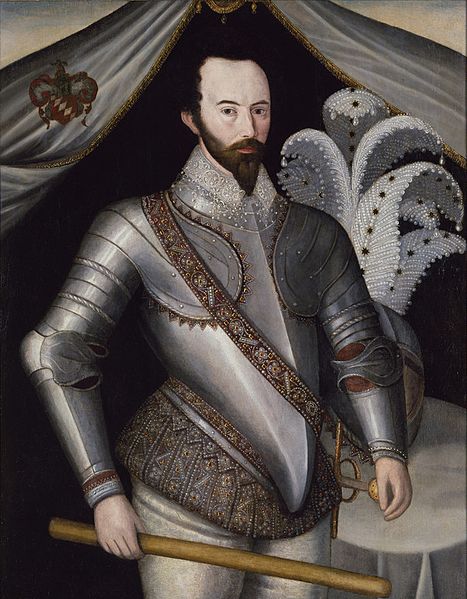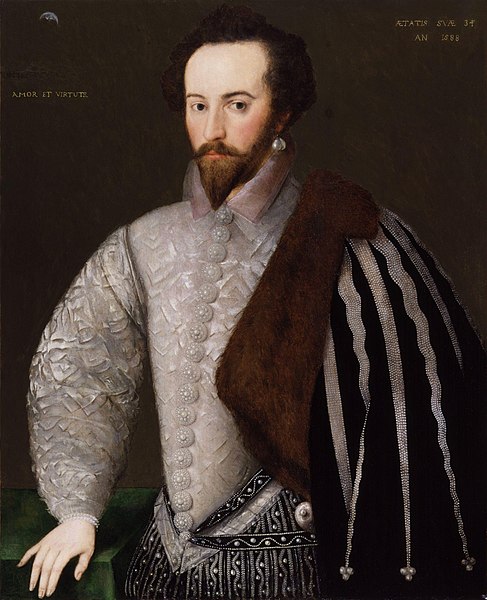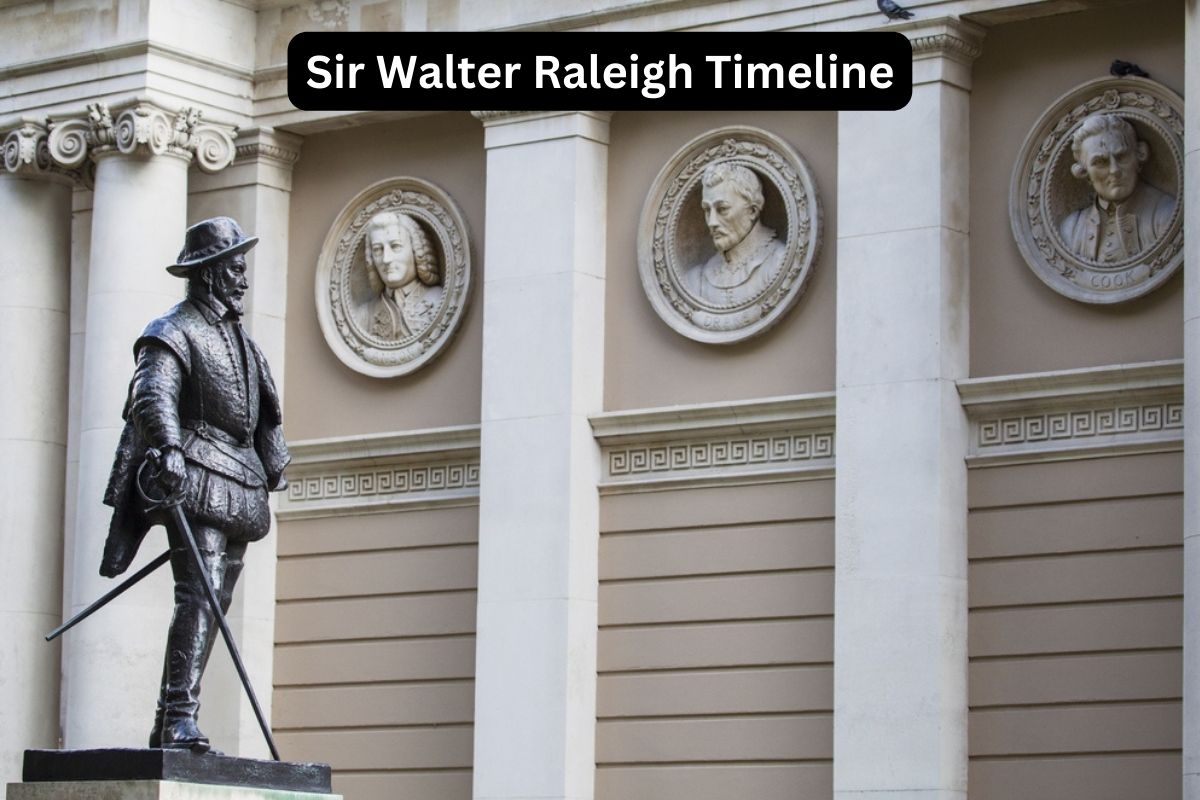Sir Walter Raleigh (c. 1552–1618) was an English explorer, soldier, and writer known for his involvement in early English colonization efforts in North America, including the establishment of the Roanoke Colony.
His life was marked by political intrigue, imprisonment, and expeditions in search of riches, notably his quest for El Dorado in South America. He authored “The History of the World” during his imprisonment.
Raleigh’s life ended tragically with his execution for treason in 1618, but he left a lasting legacy in exploration and literature during the Elizabethan era.
| Year | Event |
|---|---|
| 1552 | Approximate birth of Walter Raleigh |
| 1572 | Volunteers in the Huguenot army |
| 1580 | Elected as Member of Parliament for Devon |
| 1584 | Granted a patent for exploration and colonization in North America, establishes Roanoke colony |
| 1587 | Roanoke colony abandoned |
| 1592 | Brief imprisonment for marrying Elizabeth Throckmorton |
| 1595 | Expedition to South America in search of El Dorado |
| 1596 | Returns to England and is briefly imprisoned again |
| 1600 | Released from the Tower of London |
| 1603 | Falls out of favor at court after the death of Queen Elizabeth I |
| 1616 | Writes “The History of the World” while in prison |
| 1618 | Released from prison to lead an expedition to find El Dorado |
| 1617 | Failed expedition to South America |
| 1618 | Arrested, tried, and found guilty of treason, executed by beheading on October 29 |
Timeline of Sir Walter Raleigh
1552 (Approximate) – Walter Raleigh is Born
Sir Walter Raleigh was born in 1552 (the exact date is uncertain, but it is estimated to be in this year) in Hayes Barton, near Budleigh Salterton in Devon, England. He was born into a relatively well-off Protestant family.

1572 – Volunteer Service in the Huguenot Army
In 1572, at the age of around 20, Raleigh served as a volunteer in the Huguenot army during the French Wars of Religion. This early military experience exposed him to the complexities of European politics and warfare.
1580 – Elected as Member of Parliament
In 1580, Raleigh was elected as a Member of Parliament (MP) for Devon. This marked his entry into English politics, and he used his position to gain favor and support for his various ventures, including his plans for colonization in the New World.
1584 – Granting of the Patent and Establishment of Roanoke Colony
In 1584, Raleigh received a patent from Queen Elizabeth I, which granted him the authority to explore and colonize the eastern coast of North America. He was given the right to establish settlements and claim land for England.
Also Read: Sir Walter Raleigh Accomplishments
As a result, Raleigh financed an expedition to the New World led by Philip Amadas and Arthur Barlowe. This expedition explored the Outer Banks of what is now North Carolina and established contact with the indigenous peoples of the region.
Raleigh’s efforts eventually led to the establishment of the Roanoke Colony, though it faced challenges and was eventually abandoned.
1587 – The Abandonment of Roanoke Colony
The Roanoke Colony, established by Raleigh’s efforts in 1585, faced significant challenges, including food shortages and conflicts with the local Native American tribes.
In 1587, John White, who was appointed as the colony’s governor, returned to England for supplies. However, due to the outbreak of the Anglo-Spanish War and other factors, he couldn’t return to Roanoke until 1590.
Also Read: Sir Walter Raleigh Facts
When he did, he found the colony abandoned with the word “Croatoan” carved on a tree, suggesting that the colonists may have sought refuge with the Croatan tribe, but their fate remains a mystery to this day.
1592 – Imprisonment for Marrying Elizabeth Throckmorton
In 1592, Raleigh was briefly imprisoned in the Tower of London for marrying Elizabeth Throckmorton without the permission of Queen Elizabeth I.
The Queen was reportedly furious because Throckmorton was one of her ladies-in-waiting. Raleigh’s imprisonment strained his relationship with the Queen and temporarily halted his exploratory and colonial activities.

1595 – Expedition to South America in Search of El Dorado
Released from prison, Raleigh embarked on a major expedition in 1595 to explore the Orinoco River in what is now Venezuela. His primary goal was to find the legendary city of gold known as El Dorado.
Although the expedition did not discover the mythical city, it did provide valuable information about the geography and flora of the region. Raleigh’s account of the journey, “The Discoverie of Guiana,” contributed to European knowledge of South America.
1596 – Return to England and Brief Imprisonment
Raleigh returned to England in 1596 after his South American expedition. However, his actions in the Spanish Main, including his attacks on Spanish outposts, escalated tensions between England and Spain. He was briefly imprisoned again due to these hostilities.
1600 – Release and Return to Favor
In 1600, Raleigh was released from the Tower of London once more. He managed to regain some favor at the English court, particularly with the new queen, Elizabeth’s successor, James I, by offering his support and services.
However, his relationship with the Spanish, who had been offended by his actions in the New World, remained strained.
1603 – Fall Out of Favor and the Accession of James I
In 1603, upon the death of Queen Elizabeth I, James VI of Scotland became James I of England. Raleigh’s fortunes took a downturn as he fell out of favor at the new Stuart court.
King James I, who had been more sympathetic to the Spanish, was less inclined to support Raleigh’s aggressive policies in the New World and his conflicts with Spain.
1616 – Writing “The History of the World” While Imprisoned
While in prison during his second incarceration, which lasted from 1603 to 1616, Raleigh began to write his most famous work, “The History of the World.”
This ambitious historical text aimed to encompass the entirety of human history from ancient times to the present. Raleigh’s work was influential in its time and reflected his intellectual pursuits.
1618 – Release and Expedition to Find El Dorado
In 1618, after nearly 13 years of imprisonment, Sir Walter Raleigh was released from the Tower of London. His release was conditional on his agreement to lead another expedition to South America in search of the fabled city of El Dorado. This expedition was partly financed by himself and partly by the Crown.
1617 – Failed Expedition to South America
Raleigh’s 1617 expedition to South America, which aimed to find El Dorado, ended in failure and disaster. His men faced extreme hardships, including disease, harsh weather, and hostile encounters with the Spanish.
The expedition did not achieve its goal of discovering the legendary city or obtaining the riches Raleigh had hoped for.
1618 – Arrest, Trial, and Execution
Upon Raleigh’s return to England in 1618, his actions in attacking a Spanish outpost during the expedition worsened his relations with the Spanish government.
He was accused of violating the terms of the peace treaty between England and Spain and was arrested. He was subsequently tried and found guilty of treason.
On October 29, 1618, Sir Walter Raleigh was executed by beheading in the Old Palace Yard at the Palace of Westminster in London, bringing an end to his adventurous and tumultuous life.
The later years of Raleigh’s life were marked by his struggles to regain favor at the English court, his imprisonment, and his continued pursuit of exploration and treasure. While his quest for El Dorado did not yield the riches he sought, his writings, particularly “The History of the World,” left a lasting legacy in the realm of literature and historical scholarship. His execution marked the tragic end of a prominent Elizabethan explorer and adventurer.
